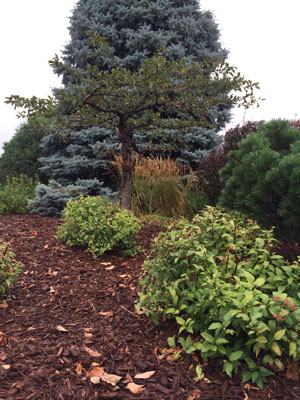Soil Science Society of America
5585 Guilford Road • Madison, WI 53711-5801 • 608-273-8080 • Fax 608-273-2021
www.soils.org
Twitter | Facebook
NEWS RELEASE
Contact: Hanna Jeske, Associate Director of Marketing and Brand Strategy, 608-268-3972, hjeske@sciencesocieties.org
Fall means mulching time in the garden
October 6, 2014—Landscape mulches come in wide arrays of colors and textures. Pine straw is common in some areas, shredded hardwood bark in others. Mulches can even be cocoa hulls or gravel. They help conserve moisture and suppress weeds, but how well they do those jobs, or how often they need to be replenished, varies from mulch to mulch, according to Susan Day, professor at Virginia Tech. And, research is showing that mulches benefit the environment by reducing erosion.

Mulches help soil retain moisture while providing beauty to your landscaping. Photo: S. Fisk
David Mitchell, a graduate student working with Day, studied how mulches would affect water runoff and sediment transport. He studied eight different mulch types and their performance. A few results stand out, and research reports are in preparation now with full details.
First, all mulches have a huge effect on total suspended solids running off site. Bare soil lost about five times as much sediment as soils with mulches covering them. Thus, mulches help control erosion.
Second, geotextiles underneath mulches (such as “landscape fabric” meant to suppress weeds) appeared to accelerate water runoff production in Mitchell’s studies.
Finally, each mulch wears differently, and absorbs a lot of runoff on its own, independent of the soil beneath it.
“Think of mulch as a temporary forest floor,” says Day. “It affects the traditional realms of aesthetics, moisture conservation, and elimination of competition for landscape plants. But, it is also an important cog in the machinery of the water cycle by keeping the soil surface receptive to water. This improves water quality by allowing the water to get into the soil, instead of the stormwater control system. Soil is an important part of the water cleansing cycle.”
The right mulch can:
- Suppress weeds
- Help soil retain moisture
- Reduce water runoff
- Reduce erosion of sediments
- Provide aesthetic value
“Ideally, landscape plantings will fill in and cover the soil surface everywhere, including mulches,” says Day. “People are starting to recognize the potential of ‘stacked’ or ‘bundled’ ecosystem services and having every piece of nonpaved land in urban areas provide multiple benefits is part of this. Mulch can play a role in making urban landscapes part of our green infrastructure.”
Day is a professor in the departments of Horticulture and Forest Services/Environmental Conservation at Virginia Tech.
This material is excerpted from a blog post on Soils Matter, a public service of the Soil Science Society of America. Soils Matter subjects are written to help the public understand that soil is a precious natural resource, http://soilsmatter.wordpress.com/. SSSA has additional soils information for the public on their www.soils.org/discover-soils website, a website for teachers, www.soils4teachers.org, and for students through 12th grade, www.soils4kids.org.